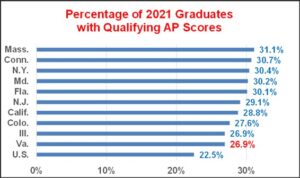Nearly 27% of Virginia’s public high school test takers demonstrated college-level achievement on at least one Advanced Placement exam this year, according to data released today by The College Board.
The good news: Virginia ranks 9th among the states in the percentage earning a score of three or higher in an AP test.
The bad news: The 26.9% percentage represents a one percentage-point decline from 27.9% since last year.
Superintendent for Public Instruction Jillian Balow did not put a happy face on the results, as past superintendents have done. While celebrating the success of 2021 graduates, she said in a press release, “We also must recognize that since 2015 the commonwealth has fallen from third in the nation to ninth as the number of Virginia students taking AP exams has declined and participation in other states has grown.”
“It is time for a serious discussion about what we can do at both the state and local levels to broaden access to AP courses and remove barriers to participation,” she added.
AP exam performance showed the usual disparities between Asian students and students of all other race/ethnicities. Here is the percentage of each group that passed at least one exam:
- Asian students — 55.9%
- White students — 29.5%
- Hispanic students — 21.9%
- American Indian students — 20%
- Black students — 8.9%
Bacon’s bottom line:
There are two stark dividing lines in AP performance — between Asian students and everyone else, and between Black students and everyone else. The high percentage of Asian achievers does not create a social-justice issue. The low percentage of Black students does.
Some of the disparity for Blacks may be explainable by the $96 charge for taking an exam, which creates a financial barrier for lower-income students. The achievement gap also may explained by the smaller percentage of Black seniors coming out of public schools who are capable of college-level work.
As The College Board notes, scores of 3 or higher in the 5-point scale may exempt Virginia students from the necessity of taking 243,000 course credits in college. At an average rate of $471 per college credit hour, that represents a potential cost savings of $114 million. Combine a higher incidence of financial hardship with inadequate academic preparation, and Black students are more likely to struggle in college, more likely to drop out, and more likely to enter adulthood staggering under a load of unpaid student debt. That’s not an outcome that anyone would wish for.
— JAB


Leave a Reply
You must be logged in to post a comment.